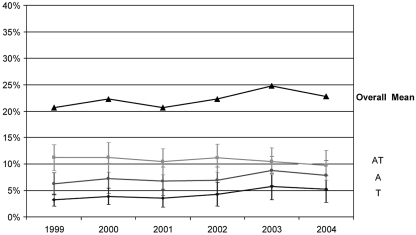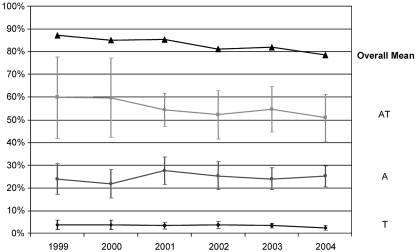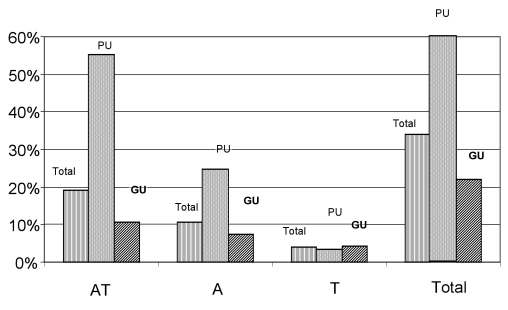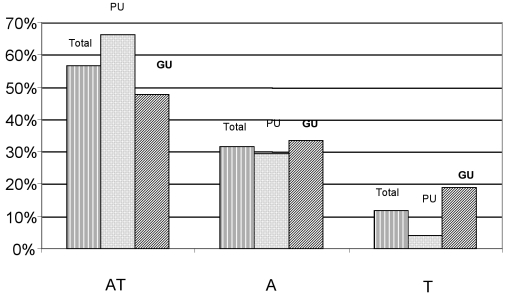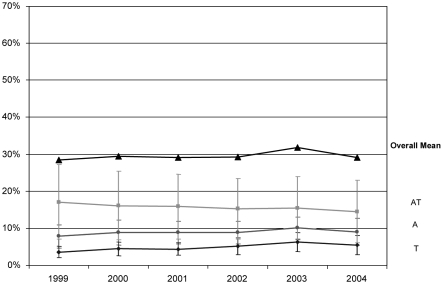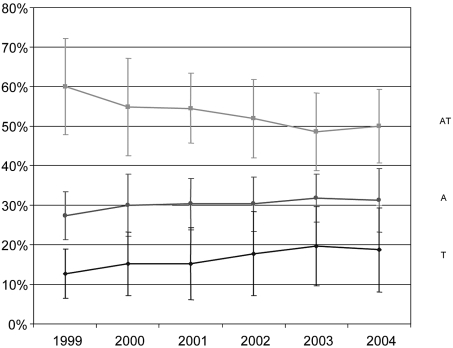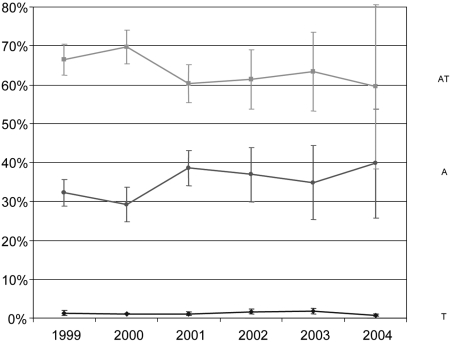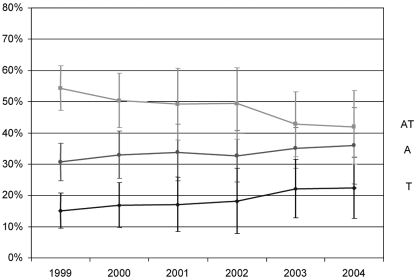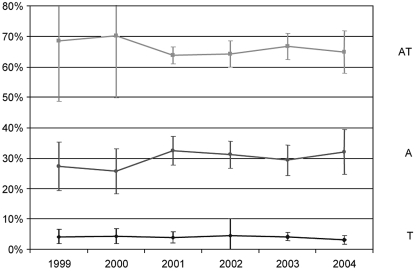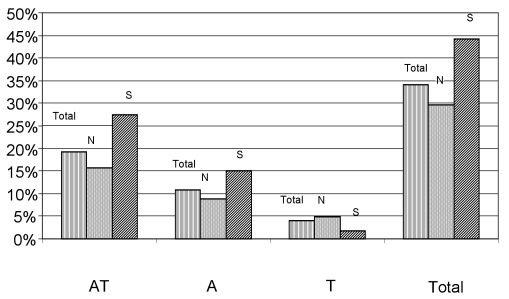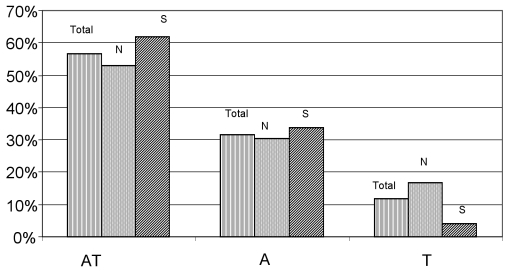Summary
Indications to surgery for adeno-tonsillar inflammatory disorders and analysis of the effectiveness of surgical treatment, compared with watchful waiting strategy, continue to be the subject of scientific debate. The present investigation focuses on the surgical activity of 14 Italian Otorhinolaryngological Units between 1999 and 2004. Surgical interventions (adeno-tonsillectomy, adenoidectomy, tonsillectomy) on 26915 children (age range: 2-11 years) were considered. Data on adeno-tonsillar interventions were analysed in relation to other interventions of ENT interest, performed in the same units and in the same period. Adeno-tonsillar interventions accounted for 35.4% of all operations of ENT interest. Adeno-tonsillectomy accounted for 56.6% of overall adeno-tonsillar operations, adenoidectomy 31.6%, tonsillectomy 11.8%. The percentage for the three interventions was homogeneous in the period of the study and in the recruited units. The percentage of children who underwent adeno-tonsillar surgery in paediatric units was higher as compared to general units, as far as concerns the overall number of operations performed. In southern Italy, the number of adeno-tonsillar interventions, in general, and of adeno-tonsillectomy, in particular, was higher compared to that in northern Italy. Results of the present study suggest that environmental factors, cultural issues and local health demands, may influence indications and, therefore, the different incidence of the operations under consideration in the units taking part in the investigation.
Keywords: Tonsillectomy, Adenoidectomy, Adeno-tonsillectomy, Multi-centric study
Riassunto
Le indicazioni al trattamento chirurgico nella patologia delle tonsille palatine e delle vegetazioni adenoidi continuano a sollecitare un vivace dibattito scientifico. La nostra ricerca ha riguardato l’attività chirurgica di 14 Centri specialistici otorinolaringoiatrici; sono stati presi in considerazione 26.915 pazienti, con età compresa fra i 2 e gli 11 anni, sottoposti ad interventi chirurgici faringei (adeno-tonsillectomia, adenoidectomia e tonsillectomia), nell’arco di tempo compreso fra il 1999 ed il 2004, per una patologia infiammatoria tonsillare e/o adenoidea; i dati relativi a questi pazienti sono stati analizzati tenendo conto degli altri interventi di interesse specialistico, eseguiti negli stessi Centri e nello stesso periodo. Gli interventi faringei costituiscono il 35,4% delle operazioni di competenza specialistica; le adenotonsillectomie incidono sul numero totale di operazioni faringee per il 56,6%, le adenoidectomie per il 31,6% e le tonsillectomie per il 11,8%. L’andamento delle percentuali medie, per i tre interventi, negli anni considerati, è omogeneo; vi è, però, una tendenza alla riduzione delle adenotonsillectomie con un corrispondente aumento degli altri due interventi. Nei Centri che operano in Ospedali Pediatrici il numero percentuale di casi sottoposto ad interventi faringei, in relazione al numero totale di operazioni, è nettamente superiore. Nel meridione d’Italia, il numero degli interventi faringei in generale e quello delle adeno-tonsillectomie in particolare, è più elevato, rispetto al settentrione. I dati raccolti nei singoli Centri, però, si discostano, talora, dalle medie per quanto riguarda sia l’andamento delle percentuali degli interventi negli anni oggetto dello studio, sia l’incidenza reciproca delle tre operazioni faringee studiate. I risultati del nostro studio e le osservazioni riportate in letteratura fanno presumere che fattori socio-ambientali, oltre che indirizzi culturali ed esigenze sanitarie locali, possano influenzare le indicazioni e la diversa incidenza degli interventi studiati.
Introduction
Scientific debates, over the last few years, have focused on the surgical indications for the treatment of inflammatory conditions of the adenoids and palatine tonsils in children and the effectiveness of surgical procedures, compared with the possibilities of watchful waiting 1 2.
A difference of opinion, on this subject, is due to the differences concerning the criteria adopted in the various studies for the evaluation of the results. This issue has assumed particular importance, since, on the basis of the results emerging from well-known randomized control trials 3 4, guidelines have been elaborated 5–8, directly or indirectly influencing clinical practice behaviour.
Aim of the study
The aim of the present research was to establish, on the basis of an epidemiological multi-centric investigation, the incidence of adeno-tonsillar surgical interventions (adeno-tonsillectomy, adenoidectomy, tonsillectomy) performed in children, in Otorhinolaryngology Units in different Italian regions, with reference to other surgical interventions of ENT interest, effected in these Units.
Material and methods
Overall, 14 Otorhinolaryngology Units took part in the study (Table I): of these, 11 were General (1, 3, 4, 6, 7, 8, 9, 11-14) and 3 Paediatric Units (2, 5, 10). Samples 1-9 are located in northern Italy; samples 10-14 in southern Italy; samples 2, 5 and 10 refer to Paediatric Units. The participating clinical units reported data related to 26,915 children who underwent adeno-tonsillar surgery (Table I), and 79,225 patients who underwent other operations of otorhinolaryngological interest, between 1999-2004 (in sample n. 2, recruitment started from 2001. In sample n. 11, recruitment was interrupted in 2003, for technical reasons). An analysis of data has been made considering the percentage of children who underwent adeno-tonsillar surgery, with reference to the overall number of operations of ENT competence performed in the same period in each of the different participating units. The percentage of cases submitted to each of the mentioned operations under study, in relation to the overall number of adeno-tonsillar procedures, was also considered.
Table I. The absolute number of adeno-tonsillar interventions is reported for each unit recruited in the study during the years of the investigation. Overall number of surgical operations has been subdivided for geographical area (northern and southern Italy) and for type of unit (General and Paediatric Units).
| Adeno-tonsillar surgery | |||||||
| 1999 | 2000 | 2001 | 2002 | 2003 | 2004 | Total | |
| Unit 1 (Conticello - Torino) | 72 | 68 | 67 | 98 | 81 | 85 | 471 |
| Unit 2 (Taormina - Torino) | 0 | 0 | 38 | 43 | 54 | 80 | 215 |
| Unit 3 (Mira - Pavia) | 385 | 408 | 433 | 531 | 528 | 590 | 2.875 |
| Unit 4 (Mevio - Magenta) | 304 | 297 | 402 | 306 | 371 | 318 | 1.998 |
| Unit 5 (Tarantino - Genova) | 918 | 901 | 845 | 849 | 837 | 787 | 5.137 |
| Unit 6 (Vicini - Forlì) | 203 | 263 | 253 | 234 | 239 | 164 | 1.356 |
| Unit 7 (Laudario - Bologna) | 254 | 382 | 353 | 445 | 592 | 482 | 2.508 |
| Unit 8 (Casolino - Cesena) | 129 | 136 | 122 | 135 | 144 | 137 | 803 |
| Unit 9 (Rinaldi Ceroni - Bologna) | 188 | 179 | 146 | 114 | 201 | 186 | 1.014 |
| Unit 10 (Mansi - Napoli) | 1320 | 1357 | 1315 | 1222 | 1168 | 1059 | 7441 |
| Unit 11 (Motta Jr - Napoli) | 102 | 113 | 57 | 66 | 64 | 0 | 402 |
| Unit 12 (Galli - Napoli) | 146 | 170 | 121 | 218 | 213 | 284 | 1152 |
| Unit 13 (Galletti - Messina) | 340 | 103 | 84 | 100 | 135 | 126 | 888 |
| Unit 14 (La Rotonda - Matera) | 108 | 118 | 98 | 151 | 111 | 69 | 655 |
| Total | 4469 | 4495 | 4334 | 4512 | 4738 | 4367 | 26915 |
| Total northern Italy | 2453 | 2634 | 2659 | 2755 | 3.047 | 2829 | 16377 |
| Total southern Italy | 2016 | 1861 | 1675 | 1757 | 1691 | 1538 | 10538 |
| Total Paediatric Units | 2238 | 2258 | 2198 | 2114 | 2059 | 1926 | 12793 |
| Total General Units | 2231 | 2237 | 2136 | 2398 | 2679 | 2441 | 14122 |
Results
Case distribution in the General Unit samples
A high variability in the number of adeno-tonsillar interventions, in relation to the overall number of operations performed, in each unit, was observed. Incidence of adeno-tonsillar interventions, as compared to other otorhinolaryngological operations, was almost homogeneous in samples 1, 3, 4, 8 and 9, while it increased progressively in samples 2 and 7 and decreased progressively in samples 6 and 13; the same parameter was highly irregular in samples 11, 12 and 14. Finally, the relative incidence of the three types of adeno-tonsillar interventions varied significantly in samples 1, 9, 11, 12, 14, but was relatively homogeneous in the other samples.
Case distribution in the Paediatric Unit samples
A lower number of adeno-tonsillar operations in sample 2, as compared to samples 5 and 10, and an almost homogeneous incidence of such operations, in the study period, was documented. A quasi-constant relationship between the types of operations considered was observed in the study period in two samples (5 and 10); this relationship was, instead, relatively variable in sample 2.
Overall distribution of the cases (Figs. 1–3)
Fig. 1.
Adeno-tonsillar interventions (% with SD) related to overall number of specialistic operations in the same years. A) Overall values. B) Data from General Units. C) Data from Paediatric Units. AT = Adeno-Tonsillectomy; A = Adenoidectomy; T = Tonsillectomy; PU = Paediatric Units; GU = General Units.
Fig. 3.
Incidence of adeno-tonsillar interventions in General and Paediatric Units. Data reported refer to: A) overall number of specialistic operations; B) overall number of adeno-tonsillar interventions. AT = Adeno-Tonsillectomy; A = Adenoidectomy; T = Tonsillectomy; PU = Paediatric Units; GU = General Units.
In the study period, a homogeneous incidence of adeno-tonsillar operations was shown, as far as concerns the overall surgical activity and the overall number of adeno-tonsillar interventions, independently of the type of units, General or Paediatric. A slightly progressive reduction in adeno-tonsillectomies, with an increase in the number of the other two interventions (adenoidectomy and tonsillectomy) was documented; this finding was more evident if General Units were considered. As far as concerns the relationships between the three operations in Paediatric and in General Units – in reference to the overall surgical activity – a higher incidence of adeno-tonsillectomy (respectively, 55% vs. 11%) and adenoidectomy (25% vs. 7%) was observed in Paediatric as compared to General Units.
Differences between northern and southern Italy (Figs. 4–6)
Fig. 4.
Percentage of adeno-tonsillar interventions, with standard deviation, related to overall number of operations of specialistic interest performed in the recruited Units of northern and southern Italy. A) Data from northern Italy Units. B) Data from southern Italy Units. AT = Adeno-Tonsillectomy; A = Adenoidectomy; T = Tonsillectomy.
Fig. 6.
Percentage of adeno-tonsillar interventions, with standard deviation, related to overall number of these operations in the same years, performed in recruited Units of northern and southern Italy. A) Data from northern Italy Units. B) Data from southern Italy Units. AT = Adeno-Tonsillectomy; A = Adenoidectomy; T = Tonsillectomy
The overall incidence of adeno-tonsillar interventions, with reference to the overall number of otorhinolaryngological operations, was higher in southern Italy compared to that in northern Italy. This finding concerned the two most frequently performed types of intervention, i.e., adeno-tonsillectomy and adenoidectomy. This incidence did not vary during the study period, either in northern or in southern Italy, although a progressive slight tendency to reduction of adeno-tonsillectomy was observed. In southern Italy, the percentage of adeno-tonsillectomies was higher compared to that in northern Italy.
Considerations
The findings of the single units participating in the investigation are not univocal and show variations during the study period. This variability is confirmed by data in the literature 4–6. In countries in which investigations have been carried out, on this issue, the frequency of adeno-tonsillectomy differs considerably (1.15% in Holland, 0.65 in England, 0.57 in USA), as also the surgical approach followed by otolaryngology specialists; adenoidectomy is performed together with tonsillectomy in 90% of cases in Holland, in 84% in USA, in 75% in Canada, in 32% in England.
Also the clinical guidelines related to indications for adeno-tonsillar interventions, proposed in USA, in Scotland and in Italy 5 7 8 differ considerably between each other. Variations in the findings, in the various study units, show that the adoption of therapeutic options can be influenced by particular clinical or environmental conditions. As a consequence, in our opinion, the decisional autonomy of specialists – as far as concerns correct clinical approach and primary deontological norms – should be guaranteed. It is worthwhile stressing that, in our investigation, during the study period, the incidence of adeno-tosillectomy appears higher (52.7-62.6%), as compared to that of adenoidectomy (28.7-33.3%) and of tonsillectomy (9.6-14.0%), if the overall incidence of adeno-tonsillar interventions is considered (Figs. 1, 2 A). In synthesis, a homogeneous surgical approach emerges if all data from the participating units are evaluated.
Fig. 2.
Percentage with standard deviation of adeno-tonsillar interventions related to overall number of these operations in the same years. A) Overall values. B) Data from General Units. C) Data from Paediatric Units. AT = Adeno-Tonsillectomy; A = Adenoidectomy; T = Tonsillectomy
The comparison between General and Paediatric Units demonstrates that the percentage of children who underwent adeno-tonsillar surgery, in relation to the overall number of operations of otolaryngology interest, is much higher in Paediatric compared to that in General Units (Fig. 1 B vs. Fig. 1 C). Nevertheless, the ratio between the three types of interventions studied does not differ substantially in the two types of samples (Fig. 2 B vs. Fig. 2 C; Fig. 3) adeno-tonsillectomies account, to a large degree, for this finding, while low frequencies, for adenoidectomies and for tonsillectomies, have been documented in both types of unit.
In the General Unit clinical series and, to a lower degree, in Paediatric Units, a slight progressive decrease in adeno-tonsillectomies has been shown with a proportional increase in adenoidectomies and tonsillectomies (Fig. 2 B vs. 2 C). In brief, in Paediatric Units, the incidence of adeno-tonsillar operations is lower compared to that in General Units; in both types of Clinical Unit, adeno-tosillectomy is the most frequent intervention performed (Fig. 3), although the number of children who underwent this surgical procedure tends towards a progressive reduction during the study period.
As far as concerns the comparison between units in northern Italy vs. southern Italy, our study showed a higher percentage (Fig. 4 A vs. Fig. 4 B; Fig. 5) of children who underwent surgery in southern Italy, as compared to northern Italy, and an analogous higher incidence of adeno-tonsillectomies, compared to adenoidectomies and tonsillectomies, in both geographical areas (Fig. 6). Briefly, in the units in southern Italy, the percentages of adeno-tonsillar interventions are higher compared to those in northern Italy and most surgical procedures refer to adeno-tonsillectomies.
Fig. 5.
Incidence of adeno-tonsillar interventions performed in recruited Units of northern and southern Italy. Data reported refer to: A) overall number of specialistic operations; B) overall number of adeno-tonsillar interventions. AT = Adeno-Tonsillectomy; A = Adenoidectomy; T = Tonsillectomy; N = northern Italy; S = southern Italy.
As mentioned in the introduction, a problem of particular interest has been raised by the clinical trials of Paradise et al. 3 9 and by others, on the effectiveness of surgical treatment for acute recurrent throat infections and for otitis media 4 10 11.
In these studies, indication to surgical treatment is advanced when symptoms are particularly serious or when watchful waiting and medical care are not effective. On the contrary, in those cases in which feverish episodes show a low incidence, the above-mentioned Authors express doubts concerning value of the surgery, bearing in mind the possible complications secondary to surgical procedures. In fact, in these studies, the results of surgical treatments have been evaluated exclusively taking into consideration feverish episodes and the clinical manifestations related to feverish episodes.
Findings emerging from the present investigation show that data on surgical treatments for adeno-tonsillar inflammatory status in children are substantially univocal in our Country. Nevertheless, in some units, variations in the incidence of the single type of operation have been documented during the study period. This finding can be explained, bearing in mind various environmental, social and economic factors that medical specialists cannot ignore, obviously in keeping with the deontological codes.
Therapeutic indications must take into considerations the economic conditions of patients and the characteristics of the environment in which they live. That is why we cast some doubt on the proposals of the “Guidelines”, aimed to better define indications to surgical treatments on pharyngeal lymphatic structures; these documents, in fact, are formally based on rigorous – but not unexceptionable – studies, in which elements of remarkable criticism are neglected. In this regard, we should stress that these studies were developed in other Countries and, therefore, results cannot automatically be transferred to other socio-economic and cultural conditions.
Conclusions
The present study concerned the surgical activity of 14 Otorhinolaryngological Units; 26915 children, aged between 2 and 11 years, underwent surgical interventions (adeno-tonsillectomy, adenoidectomy and tonsillectomy), between 1999 and 2004, for the treatment of inflammatory adeno-tonsillar conditions. Data related to these patients have been analyzed considering the other interventions of specialistic interest, performed in the same units. The study revealed that adeno-tonsillar operations account for approximately 34% of all ENT interventions and that of the overall number of adeno-tonsillar operations, adeno-tonsillectomy accounts for 56.6%, adenoidectomy for 31.6% and tonsillectomy for 11.8%. The percentage of the three interventions considered was homogeneous, in the study period, although adeno-tonsillectomies showed a tendency towards reduction, with a corresponding increase in the other two interventions.
The findings from the single participating units are sometimes not entirely in agreement with the mean values, such as, for example, the percentages of the interventions during the study period, and also the reciprocal incidence of the three operations. With reference to reports in the literature, regarding the non-uniformity of the incidence of operations on pharyngeal lymphatic structures in other Countries, it is tempting to suggest that environmental factors, different cultural background and local health systems may influence indications and, therefore, the incidence of the interventions studied.
References
- 1.Rosefsky JB. Tonsillectomies and adenotonsillectomies. Will the debate never be over? Pediatrics 2003;112:205. [DOI] [PubMed] [Google Scholar]
- 2.Paradise JL. Effectiveness of tonsillectomy depends on stringency of indications. Electronic letter 2005; http://adcbmjjournals.com/cgi/letters. [PMC free article] [PubMed]
- 3.Paradise JL, Bluestone CD, Bachman RZ, Colborn DK, Bernard BS, Taylor FH, et al. Efficacy of tonsillectomy for recurrent throat infection in severely affected children: results of parallel randomized and nonrandomized clinical trials. N Engl J Med 1984;310:674-83. [DOI] [PubMed] [Google Scholar]
- 4.van Staaij BK, van den Akker EH, Rovers MM, Hordijk GJ, Hoes AW, Schilder AGM. Effectiveness of adenotonsillectomy in children with mild symptoms of throat infections or adenotonsillar hypertrophy: open, randomised controlled trial. BMJ 2004;329:651-6. [DOI] [PMC free article] [PubMed] [Google Scholar]
- 5.Baglio G, Bellussi L, Calia V, Canonico D, Denuccio C, De Vincentiis M, et al. Programma Nazionale sulle Linee Guida (PNLG4). Appropriatezza clinica e organizzativa degli interventi di tonsillectomia e/o adenoidectomia. Documento d’indirizzo (Isituto Superiore di Sanità): aprile 2003.
- 6.van Staaij BK, van den Akker EH, van der Heijden GJMG, Schilder AG, Hoes AW. Adenotonsillectomy for upper respiratory infections: evidence based? Arch Dis Child 2005;90:19-25. [DOI] [PMC free article] [PubMed] [Google Scholar]
- 7.American Academy of Otolaryngology – Head and Neck Surgery. 2000 Clinical Indicators Compendium. Alexandria, VA: 2000:19 [Bulletin June 2000, Vol 19, No. 6]. [Google Scholar]
- 8.Scottish Intercollegiate Guidelines Network. Management of Sore Throat and Indications for Tonsillectomy. Edinburgh: SIGN Publication 1999. p. 34. [Google Scholar]
- 9.Paradise JL, Bluestone CD, Colborn DK, Bernard BS, Rockette HE, Kurs-Lasky M. Tonsillectomy and adenotonsillectomy for recurrent throat infection in moderately affected children. Pediatrics 2002;110:7-15. [DOI] [PubMed] [Google Scholar]
- 10.Koivunen P, Uhari M, Luotonen J, Kristo A, Raski R, Pokka T, et al. Adenoidectomy vs. chemoprophylaxis and placebo for recurrent acute otitis media in children aged under 2 years: randomised controlled trial. BMJ 2004;328:487. [DOI] [PMC free article] [PubMed] [Google Scholar]
- 11.Oomen KP, Rovers MM, van den Akker EH, van Staaij BK, Hoes AW, Schilder AG. Effect of adenotonsillectomy on middle ear status in children. Laryngoscope 2005;115:731-4. [DOI] [PubMed] [Google Scholar]




